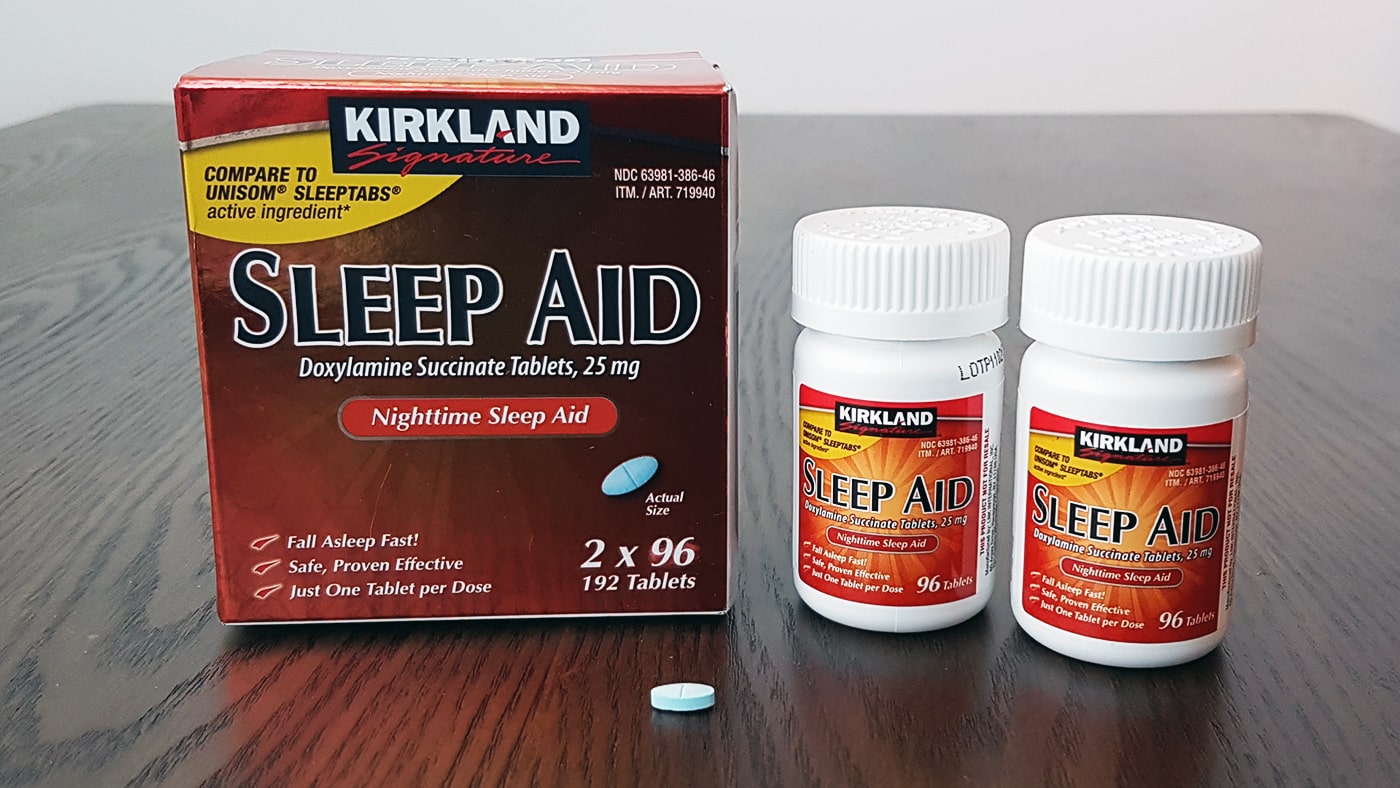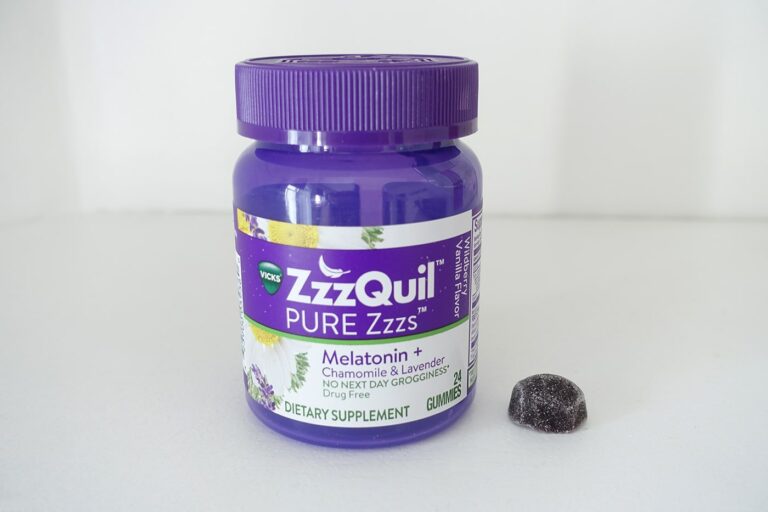
Disclosure: This review is based on my personal experience of the Kirkland Signature sleep aid, and you may have a different experience. Please discuss taking any new sleep aid with a qualified healthcare professional rather than only relying on online sources.
Updates: I first wrote this article in 2019 when I took the Kirkland sleep aid. The most recent update in 2024 was to remove the warnings and side effects listed when I bought it as they may have changed over time, and to add a further reading section.
My experience
In the photo above, you can see the exact Kirkland Signature sleep aid that I took every night for a week to see if it would help me through a patch of insomnia. As it’s an antihistamine, I was also curious to see if it would help with my dust mite allergy, which has been flaring up again recently.
Kirkland Signature is a private brand of Costco, and their sleep aid is available over the counter and online in the United States, which is where I bought it. The main active ingredient is the antihistamine doxylamine succinate, which is also used in some other brands of sleep aids.
For example, another sleep aid I’ve tried – Unisom SleepTabs – had the same ingredients when I bought them. Perhaps that’s why there was a statement on the Kirkland label that it’s not made by the same company!
How I judge how well it works
When I write a review of a sleep aid, it’s admittedly based on a subjective experience. I do keep a manual sleep diary, noting points like the approximate time I think I fell asleep, any wakings in the night, and the time I wake up. I also use a Fitbit to track my sleep and compare that with my manual notes.
The reality, however, is that it’s very hard to know if the effects I notice and sleep times are due to the sleep aid, the placebo effect, other factors, or a combination of those. Importantly, I try my best to keep an eye out for any clear effects, including unwanted side effects.
The first night
My first impression was that the Kirkland sleep aid is, like Unisom, very small and easy to swallow.
The instructions on the box were to take one tablet 30 minutes before going to bed. So I took one just as I got into bed and then stayed awake reading for a while. I always like to read after taking a new sleep aid for the first time to see if there are obvious signs of drowsiness.
Since I was staying at a friend’s house which is notoriously dusty (sorry if you’re reading this!), I also wanted to see if it would stop me from sniffling due to my house dust mite allergy.
After around 30 to 40 minutes of reading, I did feel that my nose was less irritated. I didn’t feel any obvious drowsiness, but I turned the light off to go to sleep anyway.
I woke up around 6.5 hours later, which is a reasonably good night’s sleep for me; not quite as much sleep as I’d ideally like, but enough. I often wake in the night at least a couple of times, and an average good night for me normally means somewhere between six and seven hours of sleep.
Groggy feeling in the morning
I felt a little groggy on first waking up, but it cleared up after a shower and coffee. This was again very similar to the first time I took Unisom. I was partially expecting to have some next day side effect like a cloudy head, so it didn’t surprise me. It was something I would keep an eye on as the week went by though as I would stop taking the sleep aid if it got much worse.
The following nights
As I was expecting, the pattern for the rest of the week when taking the Kirkland sleep aid was quite similar to the Unisom SleepTabs. It wasn’t exactly the same though, just to be clear.
One thing is for sure: it definitely helped in my eternal battle with the invisible hordes of dust mites.
As for sleep, I slept quite well for five of the remaining six nights, despite some sporadic wakings. On the fifth night, I really didn’t feel any drowsiness and also had a restless night. Maybe I slept well again on the final night through tiredness. It’s impossible to say for sure.
Increasing morning grogginess
The groggy next-day effect increased throughout the week, as it has done with all the antihistamine sleep aids I’ve tried in the past. This almost seems inevitable when I take them for a week, which is why I rarely take them for more than a few nights at a time.
By the fourth morning, it was taking a couple of hours to transition from what I’d describe as 70% alertness on waking to 100% alert.
Still, it’s a trade-off I can sometimes accept for what felt like a reasonably good night’s sleep. It’s better than the lack of alertness I feel after a really bad night of endless tossing and turning, especially if my allergy is triggered.
My conclusion
All in all, my feeling is that the Kirkland sleep aid did its job of helping me fall sleep when I’d been having trouble sleeping in the previous days.
While the side effects were tolerable for me, I wouldn’t want to push it and keep taking it for longer. I also prefer to take sleep aids on a temporary basis and return to sleeping naturally as soon as possible.
The big caveat, as always, is that I just don’t know how much the placebo effect or other factors contributed to my sleep. I feel fairly confident that removing my allergy sniffles was helpful. But I can’t say for sure how much the sleep aid helped other than my feeling that it did, and the sleep tracker data which seemed to back up how much sleep I thought I got.
So please keep in mind that my experience is just one person’s, and different people can react differently to sleep aids.
What evidence is there that the Kirkland sleep aid works?
As with most over the counter sleep aids, the manufacturer doesn’t need to conduct clinical trials to sell it. All they need to do is adhere to the standards in the country where supplements and ingredients of this type are concerned.
So, it’s useful to see what evidence there is that the active ingredient works as a sedative. For that, there’s no shortage of websites that talk about it causing drowsiness. But, medical websites also have warnings and precautions about using it for sleep (I’ll link to some at the end of this article).
In a journal article published in 2012, researchers pointed out that doxylamine has been an established drug for more than 50 years:
Currently, doxylamine medicinal products have been authorized for more than 50 years, with an appropriate extent of use, for symptomatic treatment of occasional insomnia, making doxylamine a drug with a well established use.
However, a team of researchers in 2015 examined previous research studies into over the counter sleep aids and had this to say:
Currently available literature suggests that commonly used OTC sleep agents, especially antihistamines and valerian, continue to lack robust clinical evidence supporting efficacy and safety in relevant populations
This lack of evidence might also be reflected in the fact that some websites with many customer reviews have a mixture of people saying sleep aids like this one either work well or do nothing at all.
Further information
Listed ingredients in 2019
According to the patient leaflet in the box of Kirkland sleep aid I bought in 2019, these are the ingredients:
Active ingredient
- Doxylamine Succinate 25 mg
Inactive ingredients
- Dibasic calcium phosphate
- FD&C blue no. 1 aluminum lake
- Magnesium stearate
- Microcrystalline cellulose
- Sodium starch glycolate
Warnings and potential side effects
It’s always wise to check with your doctor or a qualified healthcare provider that a sleep aid is safe and appropriate for you to take, even if it’s available online or over the counter. They can give you personalised advice rather than relying on the brief description on a box or label.
When I got mine, it came with a list of warnings for which groups of people shouldn’t take it. I won’t list the warnings here because they may change over time and I don’t want anyone reading this to think it’s a complete list. They also didn’t include warnings for older adults, which I think is important to consider.
Like most over the counter sleep aids, the manufacturer is not required to list every possible side effect. This is one of the issues with sleep aids sold as supplements rather than prescription medicines.
In the further reading section below, I’ll link to some websites where you can do some background reading about the Kirkland sleep aid, antihistamine use for sleep, and doxylamine succinate
Just to reiterate, it’s important to check with a qualified healthcare provider that the Kirkland Signature sleep aid is appropriate for you to take.
Further reading
WebMD – has an extensive section on the active ingredient doxylamine succinate.
Drugs.com – shows the packaging insert for Kirkland sleep aid.
Mayo Clinic – Q&A about using antihistamines for sleep. The website also has lots of information about sleep and sleep aids.
Research study in 2017 – discusses the risks for older adults using antihistamines for sleep.
Research study in 2015 – also discusses the risks with older adults using antihistamines.
NIH article in 2023 – discusses several issues with doxylamine, such as toxicity.




